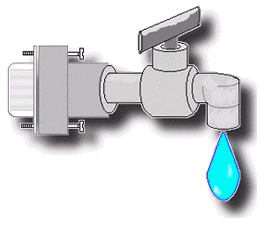|
|
|
|
Because a sender
and receiver can't always process data at the same rate, some method of
negotiating when to start and stop transmission is required. The Serial
Driver supports two methods of controlling serial data flow. One method
relies on the serial port hardware; the other is implemented in software.
Hardware flow control uses
two of the serial port signal lines to control data transmission. When
the Serial Driver is ready to accept data from an external device, it
asserts the Data Terminal Ready (DTR) signal on pin 1 of the serial
port, which the external device receives through its Data Set Ready
(DSR) input.
Flow control can also be
handled in software by using an agreed-upon set of characters as start
and stop signals. The Serial Driver supports XON/XOFF flow control,
which typically assigns the ASCII DC1 character (also known as
control-Q) as the start signal and the DC3 character (Device Code3
(control-S)) as the stop signal, although you can choose different
characters.
Obviously, the flow control is
done as a part of the data stream; you need to insert
special things in your data to make it flow or stop. This technique is
called in-band signaling. The two biggest disadvantages of in-band
signaling are that you continuously need to monitor the data stream, at
high speed, to find the signals, and if one of the DTE happens to send
an In-band Signal as part of the data, unpredictable things may happen!
See In-band flow part for more information. |
|
|
|
|
|
| The method of
exchanging signals for data flow control between computers and data
sets is called handshaking. The most popular and most often used
handshaking variant is called XON/XOFF; it's done by software, while
other methods are hardware-based. |
|
|
|
|
Two bytes that
are not mapped to normal characters in the ASCII char set are called XON
(Device Code1 (DC1), Ctrl-Q, ASCII 17) and XOFF (Device Code3 (DC3),
Ctrl-S, ASCII 19). Whenever, either one of the sides wants to interrupt
the data flow from the other (e.g. full buffers), it sends an XOFF
Transmission Off. When its buffers have been purged again, it sends an
XON Transmission On to signal that data can be sent again. With some
implementations, this can be any character.
XON/XOFF is of course limited to text
transmission. It cannot be used with binary data since binary files tend
to contain every single one of the 256 characters. That's
why hardware handshaking is normally used with modems,
while XON/XOFF is often used with printers and plotters and terminals. |
|
|
|
|
| The Data
Terminal Ready and Data Set Ready signals of the serial port can be used
for handshaking purposes, too. Their names express what they do: the
computer signals with DTR that it's ready to send and receive data,
while the data set sets DSR. With most modems, the meaning of these
signals is slightly different: DTR is ignored or causes the modem to
hang up if it is dropped, while DSR signals that a connection has been
established. |
|
|
|
|
| While DTR and
DSR is mostly used to establish a connection, RTS and CTS have been
specially designed for data flow control. The computer signals with RTS
Request To Send that it wishes to send data to the data set, while the
data set (modem) sets CTS Clear To Send when it's ready to do one part
of its job: to send data through the phone wires. |
|
|
|
|
Using a separate
channel for signaling (than the voice or data channel).
The separate channel may be
physically separate wires, or may be a time-multiplexed channel (such as
an ISDN channel). While this often costs more it ensures that the full
bandwidth is available for the voice or data.
For example, an EIA-232 interface
using RTS/CTS (Request to Send/Clear to Send) flow
control is out-of-band flow control, since these signals (pins 4 and 5)
are separate from the data. |
|
|
|
|
| As in
In-bandwidth, that is, using the same bandwidth (wires or data channel)
for signaling (sending control information) as for data transmission. |
| Examples of
in-band signaling include the following: |
- On an EIA-232 interface,
sending and receiving the x-on and x-offx-on or x-off
characters in them) flow control characters (11_16 and 13_16) on
pins 2 and 3--that is, as part of the sent and received data
(this means that the data cannot have any
- On a standard touch-tone
(DTMF) telephone or service type II switched 56 data
set, sending the phone number dialed to the central office on the same
pair of wires that the voice or data communications uses
|
| While usually
less expensive to implement than an out-of-band signaling method,
in-band signaling is usually undesirable, since it restricts or disrupts
the data that can be sent.
Also, in-band signaling leaves
the possibility that users can inadvertently (or
purposely) affect the signaling.
For example, on standard
telephone connections the telephone company uses a
2,600-Hz tone to indicate that a long-distance call is completed, and
sending one at the right time can provide free long-distance calls.
People who often call themselves "phone freaks" make or buy blue boxes,
which can generate this tone. Mind you, this is theft of
telecommunications services, a bad thing to do. The Usenet newsgroup
alt.2600 has many people trying to fool others that they have done
this, trying to entrap people that do this, and claiming that others are
trying to entrap others.
|
|
|
|
|
|
